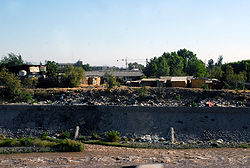Population callampa
The term callampa population is used in Chile to refer to informal settlements of a temporary nature, materialized through the seizure of land during the decades from 1950 to 1980. One of the best known is the Toma de La Victoria in 1957. The analogy that explains the name callampa (synonymous with “mushroom”) reflects the speed with which these substandard housing sectors reproduce - overnight the same as the "callampas" They grow in gardens.
History
Until the 1940s, legal housing occupation predominated in Santiago. With the explosive growth and product of the housing problem that this generated, people were locating themselves in territories that were not of great interest as they were on the outskirts of the city. Land seizures were a new way of obtaining housing, expanding the city towards the periphery. However, from 1950 to 1980, an illegal occupation of land predominated. This was generated because the offer of purchase and rental was was overwhelmed by the increase in demand produced by the arrival of migrants who came to live in the capital.
It is thought that the callampa population is synonymous with camps; however, they differ because the first does not seek to be a definitive solution to the housing problem. The callamperos settle in these vacant lots, while they wait for the definitive solution on the part of the authorities. the precariousness of the homes and the illegal nature of the occupation of land. This last characteristic is shared with the camps, since they also originate from land seizures, but the actors have an intention of definitive settlement.
Around 1952, a total of 75,000 people lived in the callampas, 6.25% of the total population of Santiago. In 1966, they were around 200,000, corresponding to 8.05% of the total inhabitants of the capital. Based on data from the Ministry of Housing and Urban Planning, in 1970 there was an average daily intake. The average density was 170 inhabitants per hectare.
The shots are also considered part of a social movement, trying to change the established system in which people were immersed. They are the product of an organized action, having a community and identity dimension. Over the years, this movement was integrated into national politics, undertaking negotiations with the State.
The State's response to these illegal settlements was to continue with the construction of towns through the Housing Fund, encouraging individuals to promote construction. Another solution was to mobilize the inhabitants of the towns to other parts. The governments of Gabriel González Videla, Carlos Ibáñez del Campo and Jorge Alessandri carried out eradicating efforts. A massive transfer of inhabitants was made from the transitory land, to others that had been subdivided and urbanized by the State, where the construction of permanent homes began.
In 1954, the Housing Corporation (CORVI) was created, which built the town of San Gregorio and José María Caro. Later, Eduardo Frei Montalva through the "site operation" motivated the self-construction of the residents, giving them the land with the basic urbanization tools: latrines, gravel streets, pavements, potable water pylons and power lines. However, this did not eradicate the mushroom populations that became more common.
During the Popular Unity (1970-1973), the massive expropriations of private property by the government served to promote around 2,000 land seizures by groups of settlers (as an inhabitant of a town is called). land seizure) throughout the country. In most situations, they built houses under precarious conditions, with light material and serious infrastructure and composition problems, quantitatively strengthening the social movement of "pobladores".
News
Early settlements today are configured practically as populations where low-middle income sectors or eventually low-income citizens reside. However, the late settlements (1980s) have not been able to complete this conversion phase and from the 1990s to the present, they have been eradicated in favor of the installation of social housing (low, semi-detached houses and blocks (Apartments) of 3 floors or more), where these families are rehoused after prior savings added to a State subsidy.
These sectors are grouped fundamentally in the intermediate periphery of the city, between the historic center of the cities, surrounded by nuclei of upper-middle class sectors and the populated periphery of the new middle class, upper-class condominiums and some hidden nucleus of camps (homelessness).
They are similar to the Brazilian favelas, the Spanish shanties, the Uruguayan cantegriles, the slums Argentines, Costa Rican slums, Peruvian pueblos jovenes.
Contenido relacionado
The Argañán Hostel
Plaka
Solifluction


